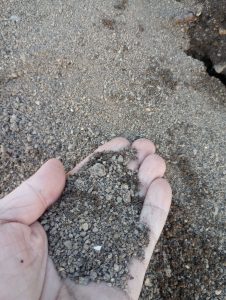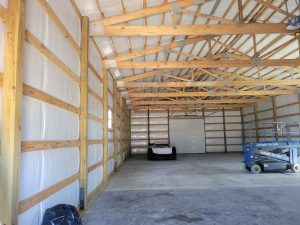Loyal blog reader and video watcher DANIEL in SULPHUR writes:
“What practices are best for increasing wind rating of a post frame building? My goal is to build a post frame home to withstand 150+ mph winds. I live on the gulf coast and hurricanes are a serious threat, I know I can’t make my building hurricane proof but I’d like to get it real close. My build site is surrounded by trees so I know that helps. Examples might be: -In ground posts vs wet set brackets -Smaller distances between posts and trusses 8 ft centers vs 12 ft centers – Additional trusses. Thank you for your blogs and videos I’ve read a bunch of them and watched almost every video!”
Daniel ~Thank you for reaching out to me and for being a loyal follower! It is greatly appreciated.
We have provided fully engineered post frame buildings with design wind speeds of 170 mph (and could do in excess of 200 mph) and Exposure D (fully exposed to ocean winds). If your building site is fully protected on all four sides by trees, hills or other buildings 30 feet or greater in height, then you would technically be Exposure B for wind, however if you think they might every be removed in any direction (either purposefully by mankind or due to a hurricane) it might be prudent to opt for an Exposure C design. An Exposure C design makes your building roughly 20% more wind resistant than Exposure B (but does not require a 20% greater investment).
Our structural design software has been developed by our programmers under watchful eyes of our engineers and it checks every component and connection for structural adequacy for any given load combination. Merely reducing column spacing, having larger columns, more trusses, etc., will not make any difference, if even just one small connection happens to be under- designed. Our system allows us to incrementally adjust design wind speeds even one mph at a time, so we can provide you with numbers for a plethora of different design wind speeds so you can make a fair determination of what you are willing to invest.
Your weakest link is going to be windows, if enough of them get blown in (or more likely sucked out) it will increase wind pressures inside of your building shell by roughly a third – this is most often what causes those dramatic photos of roofs having been sucked off from buildings after traumatic wind events. While I have not used them myself, I have been interested in offerings from www.RiotGlass.com. While I doubt it is a cheap investment, if it keeps your home intact it could certainly be worth your looking into further.
As far as your building shell itself, embedded columns are more likely to survive a catastrophic wind event than wet set brackets would, due to continuity of materials and not having to rely upon a connection at ground level.
Tag Archives: hurricanes
Project Superstorm Sandy
 For more than 30 years the trade group at F+W Media has served the construction industry. Now they are coming together to serve the Red Cross and those communities most devastated by Superstorm Sandy by creating the website www.projectsandy.net. The companies listed in this guide (including Hansen Pole Buildings) are well established businesses which have earned their reputations as solid, trustworthy suppliers to the trade. They have the resources and dedication to help with rebuilding efforts.
For more than 30 years the trade group at F+W Media has served the construction industry. Now they are coming together to serve the Red Cross and those communities most devastated by Superstorm Sandy by creating the website www.projectsandy.net. The companies listed in this guide (including Hansen Pole Buildings) are well established businesses which have earned their reputations as solid, trustworthy suppliers to the trade. They have the resources and dedication to help with rebuilding efforts.
This special construction resource guide is devoted to helping restore the homes, businesses and lives torn apart by Superstorm Sandy. The businesses listed on the Project Sandy website are prepared and ready to assist now. A portion of the proceeds from Project Sandy will be donated directly to the American Red Cross toward rebuilding efforts.
Superstorm Sandy did tens of billions of dollars in damage to coastal areas of New York and New Jersey. New York and New Jersey are seeking at least $60 billion in emergency federal funding, but Congress is still debating the request. From past experiences with hurricanes, there appears to be about a two-year lag time between the event, and the ability to actually rebuild.
“We’ve looked at really a two-year lag period after a hurricane,” he says. “And you’ll still see that the areas that are hit are a little bit below where they should have been.”
Hurricane Katrina visited New Orleans in August 2005. I was in New Orleans this past December. Driving through some of the neighborhoods which were devastated by Katrina, they sadly don’t look much different than they did over seven years ago!
To those who have had garages, shops, barns or other structures which are, or could be post frame (pole) buildings destroyed by Sandy – Hansen Pole Buildings is here to assist. We can work with insurance companies and adjusters to help make the road to recovery as expedient and pain free as possible. Let us know what your building needs are, and we will assist you on your road to recovery.
Thanks to www.ocala.com May 24, 2011 for their article, “Florida Building Codes Limit Tornado Damage”
While surveying tornado damage in Tuscaloosa, Ala., University of Florida researcher David O. Prevatt said he was struck by the city’s large number of old homes susceptible to storm damage.
“We have to expect this sort of damage unless we decide to do something differently,” said Prevatt, an assistant professor of civil and  coastal engineering.
coastal engineering.
Prevatt is the principal investigator of a research project documenting damage from the tornado that devastated Tuscaloosa last month. He’s planning to make a similar trip to Joplin, Mo., where one of the deadliest U.S. twisters on record struck Sunday and killed at least 116 people.
Prevatt believes that new building codes, like those instituted in response to hurricanes in Florida, could reduce some of the damage from tornadoes in those areas.
“We can probably save some damage and probably save some lives as well,” he said.
Hurricanes are a bigger concern than tornadoes in Florida, said David Donnelly, Alachua County’s emergency management director.
Florida, he said, doesn’t typically get the extreme twisters that have recently struck Alabama and Missouri.
“Florida as a whole doesn’t really see those type of tornadoes,” he said.
There are exceptions. In February 1998, violent tornadoes that swept across four counties in Central Florida killed 41 people. In 2007, 21 people died when tornadoes left a 70-mile trail of destruction across Lake and Volusia counties, including parts of The Villages.
Prevatt said the damage he saw in Tuscaloosa included buildings knocked off their foundations and homes where roofs were nowhere to be found. He made a trip last year to Hiroshima, so he can compare the devastation in Alabama to photos he saw of Hiroshima after the atomic bombing.
Tuscaloosa “really looked like a bomb site,” he said.
Prevatt and researchers from several other universities spent a week in Tuscaloosa documenting damage to about 150 homes. Their work is being funded by the National Science Foundation and International Association for Wind Engineering.
Now his attention is turning to Joplin, where more than 2,000 structures were leveled. He expects to travel there late this week or early next week, after conditions improve.
Modern pole building design allows for structures to be designed to withstand or reduce damage from tornado winds. Columns embedded into the ground eliminate the weak point of stick frame construction in the connection of walls to foundations. The embedment itself can be designed to withstand uplift and overturning forces for any desired wind speed.
Roof trusses can be attached directly to the columns using seven gauge steel brackets with through bolts. This connection eliminates another noted stick frame weakness – connecting trusses to wall top plates, which is typically done with either toe nails, or light gauge steel connectors.
The Florida Building Code has the most stringent wind requirements in the United States. The 29 gauge steel roofing and siding has Florida approvals to be used in hurricane regions. With appropriate spacing of framing members, this steel cladding, attached with properly placed diaphragm screws, will withstand even the highest recorded wind speeds. Pole building designs may help to reduce damage and save lives.






